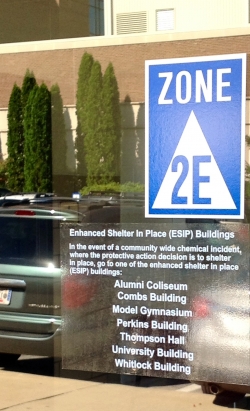EKU's Vital Signs: Knowing What to Do in an Emergency
When it comes to emergency preparedness, knowing what to do in the event of a hazardous materials release can be critical to anyone’s safety.
Since August of last year, signs with zone information have appeared around Madison County. Now, they are coming to Eastern Kentucky University. The sign project began as part of an effort from Madison County Emergency Management Agency/Chemical Stockpile Emergency Preparedness Program (EMA/CSEPP) to remind local residents of the significance of emergency response zones in the county. EKU Emergency Management is now reminding students, faculty and staff about protective actions they should take on campus if a community-wide hazardous material incident occurs.
Mimicking the road signs, EKU will post signs at the entrances of all buildings on its Richmond campus, indicating the zone of each location. For example, EKU is primarily located in Zone 2E and Zone 2D. Zone 2E is that part of the campus north of the Eastern By-Pass, and Zone 2D is that portion of campus south of the By-Pass.
What Are Zones?
Madison County is divided into 13 emergency response zones. In the event of a large-scale emergency, Madison County Emergency Management will instruct the public to take protective actions depending on what zones were impacted, so knowing zone locations is vital in order to take appropriate action.
Notifications
Sirens are designed as an outdoor warning system to alert people that an emergency has occurred or is imminent and motivate them to take shelter. Adviser Alert Radios (AARs) are designed as an indoor warning system to inform residents about dangerous conditions affecting their area. In the event of a chemical incident, Madison County EMA/CSEPP would activate these systems. Upon hearing an AAR or the outdoor warning siren, signaling a community-wide chemical emergency (a High/Low Wail), citizens should immediately shelter in place, as a default protective action, unless told to do otherwise by emergency officials.
Additionally, EKU uses Rave Mobile Safety as its Emergency Notification System to send alert information and all-clear signals to the community. Email addresses are automatically subscribed to receive EKU Alerts. Students, faculty, and staff can log into EKU Direct, click on the Rave Mobile Safety-Emergency Notifications link, and add cell phone numbers to opt in and receive text messages and voice calls. EKU can also use RSS feeds, the Alertus pop-up system for campus computers, and Facebook and Twitter feeds.
For more information about emergency notifications, visit
madisoncountyema.net/alert-and-notification#tab44-0 or www.emergency.eku.edu/emergency-notifications.
Know What to Do Rather Than Where to Go
Most residents associate knowing their zone with a pre-planned relocation point listed in the annual Madison County EMA/CSEPP Emergency Preparedness Calendar. While knowing relocation points is important, in the vast majority of chemical-related emergencies, residents will be instructed to Shelter-In-Place. This means taking shelter indoors (at home, work, school, or shopping) to wait for the danger to pass, rather than taking to the road.
Shelter-In-Place is preferred to evacuation procedures because, in the event of a chemical accident, evacuation would be too slow and potentially too dangerous to public safety.
In the event of a community-wide chemical incident, where the protective action decision is to shelter in place, EKU students, faculty, and staff should go to one of the Enhanced Shelter In Place (ESIP) buildings: Alumni Coliseum (excluding the natatorium), Combs Building, Model Lab Gymnasium, Perkins Building, Thompson Hall at the Kentucky Department of Criminal Justice Training, University Building (part of the library complex), or Whitlock Building (excluding O’Donnell Hall). Once inside an ESIP building, any individual can activate the Collective Protection System by pressing the red start button on the face of the building’s system control panel. Signs informing people about the ESIP buildings will accompany the campus zone signs.
Once officials determine the threat from the chemical accident has passed, the instruction to exit Shelter-In-Place will be given.
It is possible that after exiting Shelter-In-Place, some zones might be instructed to relocate, but that would be an additional, separate protective action to take.
Depending on where the chemical accident happened, the pre-planned relocation point listed in the Emergency Preparedness Calendar or on the EKU Emergency Management web page (www.emergency.eku.edu/hazardous-materials-csepp-chemical-stockpile-emergency-preparedness-program) may no longer be viable. Residents will need to stay tuned to local radio stations for updated information.
Knowledge of emergency response zones is vital to successfully following instructions for public safety.
“The zone signs are an additional visual reminder for residents as they travel throughout the county,” said Madison County Emergency Management Agency Director Carl Richards. “Seeing the signs will help people associate an actual familiar place with the Emergency Response Zones set for their protection.”
For more information about emergency preparedness and the Chemical Stockpile Emergency Preparedness Program, contact the Madison County EMA/CSEPP offices at 560 S. Keeneland Drive in Richmond at 624-4787, or visit www.madisoncountyema.net.
For more information about emergency preparedness at EKU, contact the Emergency Management office in Mattox Hall at 622-8987 or 622-1111, or visit www.emergency.eku.edu.
| Attachment | Size |
|---|---|
| CSEPP Zones from the Madison Co Calendar.pdf | 2.6 MB |
Published on October 17, 2014
